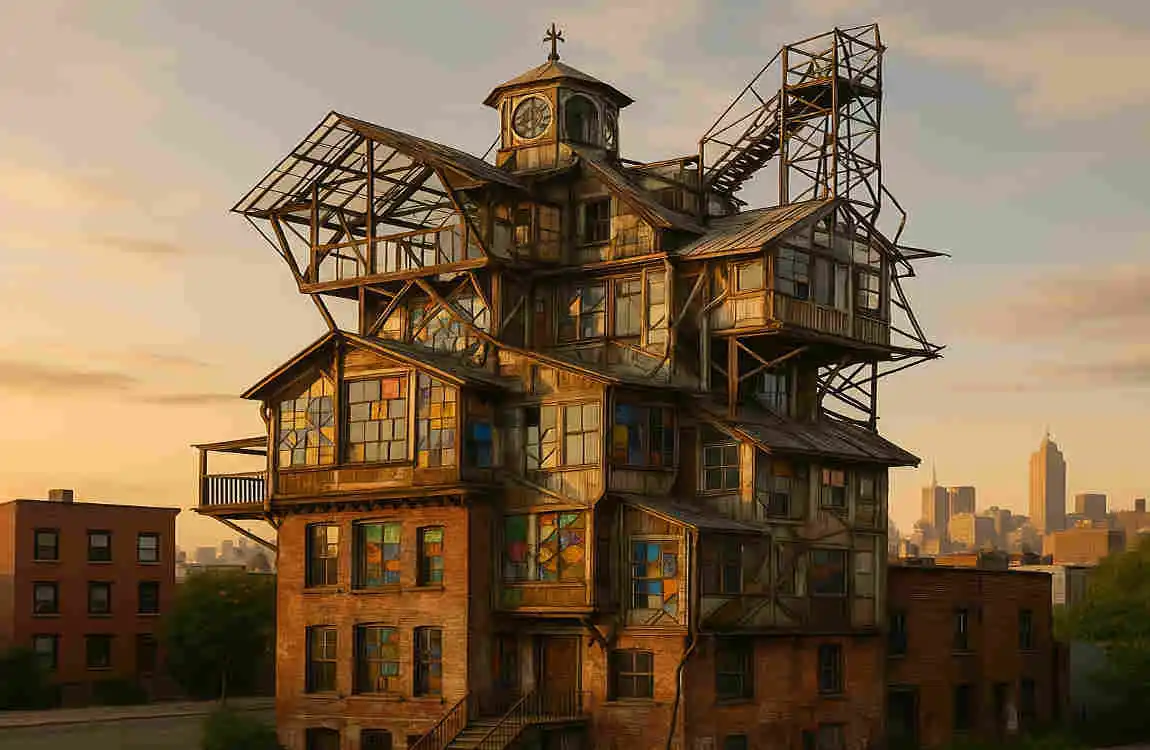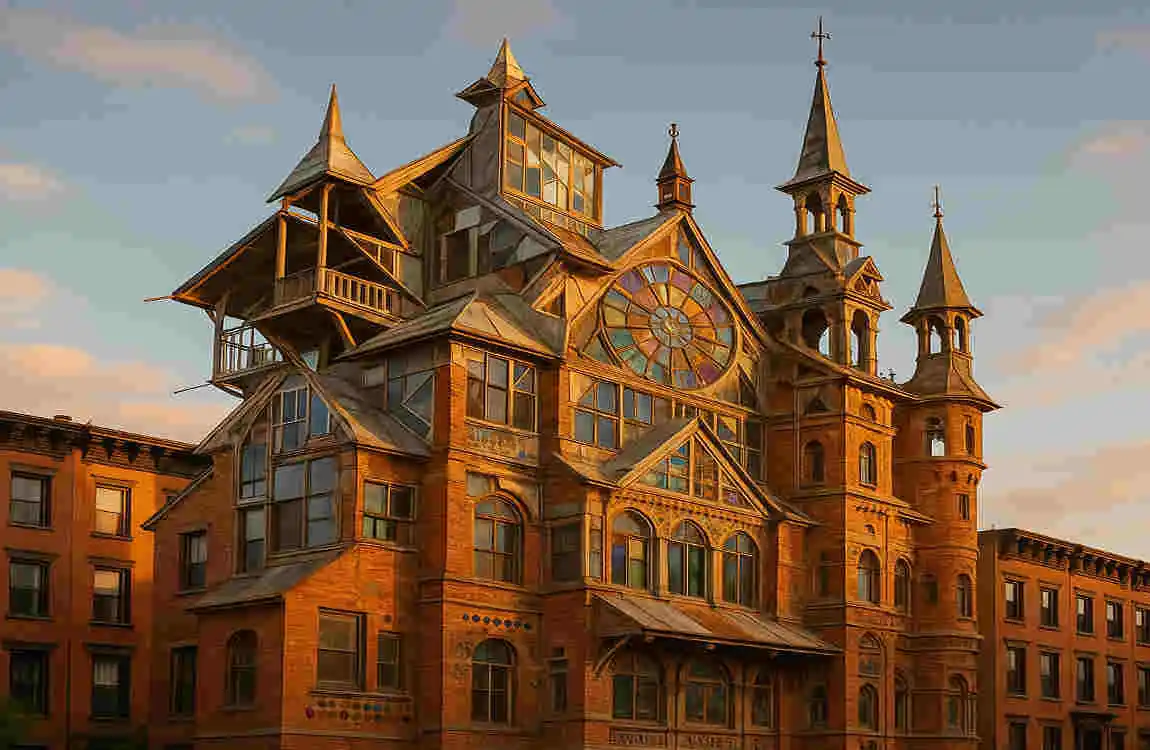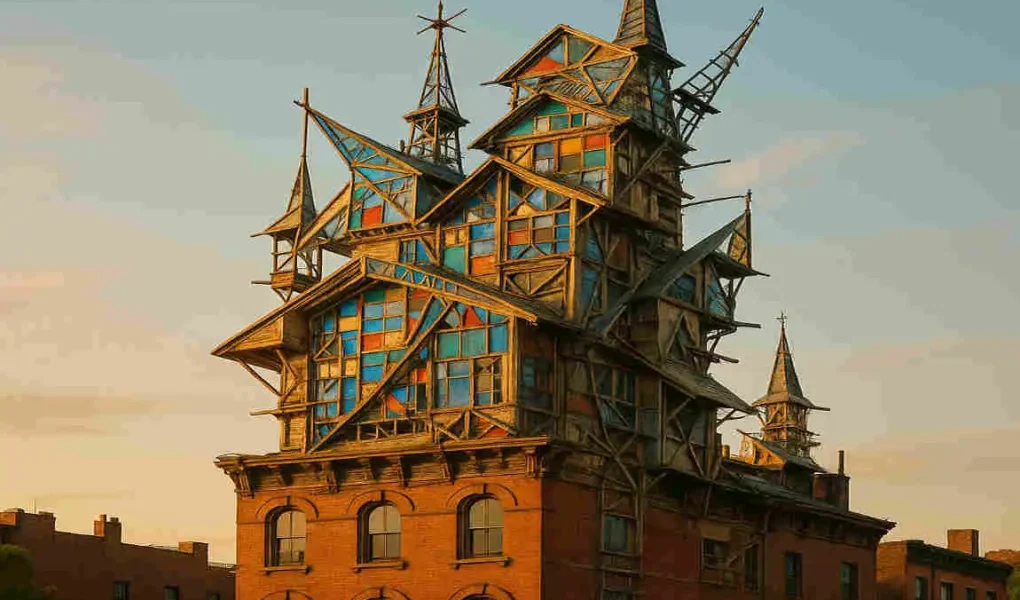Have you ever heard of a house that was more than just a home? A place that stood as a testament to creativity, resilience, and the spirit of a community? That’s precisely what the Broken Angel House in Brooklyn was. Nestled in the heart of Clinton Hill, this extraordinary structure was not just a building but a recognized piece of folk art and vernacular architecture.
The broken angel house in Brooklyn was a true marvel, a testament to the power of human imagination and the beauty that can be found in the most unexpected places.
Historical Background of the Broken Angel House

The Origins of a Masterpiece
The story of the Broken Angel House begins in 1979, when Arthur Wood and his wife, Cynthia, purchased a 19th-century brick tenement for a mere $2,100. Little did they know that this humble building would become the canvas for their artistic vision and a symbol of Brooklyn’s creative spirit.
You may also read (inside the iconic malcolm in the middle house then and now).
Arthur Wood: The Visionary Behind the Art
Arthur Wood was not your typical architect. He was a self-taught artist and architect who poured his heart and soul into transforming the tenement into a towering, nine-story sculptural work. With no formal training or blueprints, Wood relied on his intuition and a deep connection to the materials he used to create something truly unique.
The Name Behind the Legend
The name “Broken Angel” itself has a fascinating origin story. It was inspired by a broken cherub figurine that the Woods found and lovingly restored. This small act of mending became a metaphor for the entire project, as Arthur and Cynthia worked tirelessly to breathe new life into the old building, piece by piece.
A Journey of Transformation
Over the years, the Broken Angel House underwent a remarkable transformation. What started as a simple tenement slowly evolved into a towering work of art, with each addition and modification reflecting the Woods’ creative vision. However, this journey was not without its challenges. In 2006, a fire broke out, leading to safety concerns and legal battles that would ultimately shape the fate of the Broken Angel.
Architectural and Artistic Uniqueness

A Feast for the Eyes
The Broken Angel House was a visual feast, a mesmerizing blend of Gothic cathedral elements, stained glass made from found bottles, mosaic angels, and whimsical, carnival-like shapes. It was as if the building itself was a living, breathing work of art, constantly evolving and surprising those who encountered it.
A Comparison to Other Folk Art Monuments
While the Broken Angel House was undoubtedly unique, it shared similarities with other folk art monuments, such as the Watts Towers in Los Angeles and the Cathedral of Junk in Austin. These structures, born from the vision and dedication of their creators, stood as testaments to the power of individual creativity and the beauty that can be found in unconventional materials.
The Beauty of Salvaged Materials
One of the most remarkable aspects of the Broken Angel House was its use of salvaged and discarded materials from the streets and dumps of Brooklyn. Arthur Wood saw beauty and potential in what others might have considered trash, transforming these found objects into an integral part of his artistic vision. This emphasis on sustainability and creativity was a testament to the power of seeing the world through a different lens.
A Living Sculpture
The Broken Angel House was more than just a building; it was a living sculpture that seamlessly combined architecture, folk art, and outsider art. It was a testament to the idea that art can be found in the most unexpected places and that the boundaries between different forms of creative expression can be blurred.
The Philosophy of Improvisation
At the heart of Arthur Wood’s artistic philosophy was the concept of improvisation. Without formal blueprints or a set plan, he allowed the building to evolve organically, guided by his intuition and the materials he found. This approach to design reflected the countercultural ethos of the time, celebrating personal expression and rejecting the constraints of traditional architecture.
The Rooftop Sculpture and Mirrored Platform
One of the most striking features of the Broken Angel House was its rooftop sculpture and mirrored platform, which created a floating effect that was both mesmerizing and otherworldly. This addition not only enhanced the visual impact of the building but also served as a metaphor for the Woods’ journey, as they sought to elevate their home and art to new heights.
Cultural Significance and Community Impact
A Symbol of Brooklyn’s Spirit
The Broken Angel House was more than just a building; it was a symbol of Brooklyn’s spirit. It embodied the grit, authenticity, creativity, and defiance that defined the borough, standing as a beacon of resistance against the forces of gentrification and commercialization. In a world that often prioritizes profit over art, the Broken Angel served as a poignant reminder of the importance of preserving a community’s unique character.
A Local Landmark and Tourist Attraction
The Broken Angel House quickly became a local landmark and a tourist attraction, drawing visitors from around the world. People were drawn to its unique beauty and the story behind its creation, eager to experience a piece of Brooklyn’s artistic heritage firsthand. The house became a must-see destination for those seeking to explore the city’s creative side.
A Backdrop for Popular Culture
The Broken Angel House even found its way into popular culture, serving as a backdrop for Dave Chappelle’s Block Party in 2004. This exposure helped to cement its status as an iconic symbol of Brooklyn, showcasing its unique architecture and artistic significance to a broader audience.
Embodying the Countercultural Ethos
The lifestyle of Arthur and Cynthia Wood, along with the home they created, embodied the countercultural ethos of the 1960s and 1970s, a period often referred to as the Age of Aquarius. They rejected the norms of traditional architecture and embraced a more free-spirited approach to life and art. The Broken Angel House was a physical manifestation of their beliefs, a testament to the power of living life on one’s terms.
Recognition by Artists and Cultural Historians
The Broken Angel House was not only appreciated by the local community but also recognized by artists, architects, and cultural historians as a valuable piece of folk art and urban heritage. Its unique blend of creativity, improvisation, and community spirit made it a subject of study and admiration, ensuring that its legacy would endure long after its physical presence was gone.
You may also read (inside the iconic malcolm in the middle house then and now).
Challenges and Controversies
The 2006 Fire and Safety Concerns
In 2006, a fire broke out at the Broken Angel House, leading to safety concerns and a declaration by the NYC Department of Buildings that the structure was dangerous. This event marked a turning point in the story of the Broken Angel, as it brought the building under scrutiny and set the stage for the challenges that would follow.
Eviction Attempts and Legal Battles
Following the fire, Arthur and Cynthia Wood faced eviction attempts and legal battles as they fought to preserve their home and their art. These struggles highlighted the tension between the value of unconventional art and the need for safety and compliance with building codes. The Woods’ determination to protect their creation was a testament to their unwavering commitment to their vision.
Shifting Perceptions: From Art Monument to Eyesore
As the legal battles continued, public and official perceptions of the Broken Angel House began to shift. What was once celebrated as an art monument was now being labelled as an “eyesore” and a safety hazard. This shift in perspective underscored the challenges faced by unconventional art in a world that often prioritizes conformity and safety over creativity and expression.
Financial Struggles and Personal Challenges
The Woods faced not only legal challenges but also financial struggles as they tried to maintain and preserve the Broken Angel House. The situation was further complicated by Cynthia Wood’s illness and eventual death, which had a profound impact on the preservation efforts. Despite these challenges, the Woods remained committed to their vision, a testament to the power of art and the human spirit.
The Tension Between Preservation and Urban Development
The story of the Broken Angel House highlights the tension between preserving unique art and the pressures of urban development. As cities grow and evolve, the question of how to balance the need for progress with the desire to preserve cultural heritage becomes increasingly crucial. The Broken Angel’s story serves as a reminder of the importance of recognizing and valuing unconventional art in the face of these challenges.
Demolition and Legacy
The Sale and Demolition
In 2014, the property that housed the Broken Angel was sold to a developer, and the iconic structure was demolished. The loss of this unique art monument was a blow to the community and the art world, as it represented the end of an era and the erasure of a piece of Brooklyn’s history.
Community and Art World Reactions
The demolition of the Broken Angel House sparked a range of reactions from the community and the art world. Many mourned the loss of this unique landmark, recognizing its cultural significance and the impact it had on the neighbourhood. Others saw it as a symbol of the ongoing struggle to preserve unconventional art in the face of urban development.
Inspiring Discussions on Folk Art and Urban Creativity
Despite its physical absence, the Broken Angel House continues to inspire discussions on folk art, urban creativity, and architectural experimentation. Its story serves as a reminder of the power of individual vision and the importance of recognizing and celebrating unconventional art forms. The Broken Angel’s legacy lives on in the conversations it sparks and the inspiration it provides to future generations of artists and architects.
A Symbol of Brooklyn’s Artistic Identity
Although the Broken Angel House is no longer standing, it remains a symbol of Brooklyn’s artistic heritage. Its unique blend of creativity, improvisation, and community spirit continues to resonate with those who knew and loved the structure. The Broken Angel’s story is a testament to the enduring power of art and the importance of preserving a community’s cultural heritage.
Preserving the Story Through Documentaries and Memories
While the physical structure may be gone, the story of the Broken Angel House lives on through documentaries, articles, and the memories of those who experienced it firsthand. These efforts to preserve the legacy of the Broken Angel ensure that its impact will not be forgotten and that future generations will have the opportunity to learn about this unique piece of Brooklyn’s history.
Lessons from the Broken Angel House for Art and Urban Spaces
Recognizing and Preserving Unconventional Art
The story of the Broken Angel House serves as a powerful reminder of the importance of recognizing and preserving unconventional art. In a world that often prioritizes conformity and safety, it is crucial to celebrate the unique and the unexpected. By valuing and protecting these works, we can ensure that future generations have the opportunity to experience the beauty and creativity that they offer.
The Role of Individual Creativity in Shaping Urban Landscapes
The Broken Angel House is a testament to the transformative power of individual creativity in shaping urban landscapes. Arthur Wood’s vision and dedication transformed a simple tenement into a towering work of art, demonstrating the power of one person’s imagination to transform a community’s face. By encouraging and supporting individual creativity, we can foster vibrant and unique urban spaces that reflect the spirit of their inhabitants.
Balancing Safety, Development, and Cultural Heritage
The challenges faced by the Broken Angel House underscore the need to strike a balance between safety, development, and cultural heritage in urban planning. While it is essential to ensure the safety and well-being of residents, it is equally crucial to recognize and protect the cultural landmarks that give a community its character. By finding ways to preserve these spaces while still allowing for growth and development, we can create cities that are both safe and culturally rich.
Encouraging Community Engagement with Local Art Monuments
The Broken Angel House was not just a building; it was a beloved part of the Clinton Hill community. Its story underscores the importance of encouraging community engagement with local art monuments. By fostering a sense of ownership and pride in these spaces, we can ensure that they are valued and protected for generations to come.
Inspiring Future Artists and Architects
Finally, the story of the Broken Angel House can serve as an inspiration to future artists and architects. Arthur Wood’s unconventional approach to design and his unwavering commitment to his vision demonstrate the power of following one’s creative instincts. By sharing his story and celebrating his achievements, we can encourage the next generation of creatives to push boundaries and create works that challenge and inspire.
Conclusion
The broken angel house in Brooklyn was more than just a building; it was a unique and irreplaceable art monument that captured the spirit of a community and the power of individual creativity. Through its history, artistic significance, architectural uniqueness, and cultural impact, the Broken Angel House stood as a testament to the beauty that can be found in the most unexpected places.
While the physical structure may be gone, the legacy of the Broken Angel lives on in the memories of those who experienced it and the discussions it continues to inspire. Its story serves as a reminder of the importance of recognizing and preserving unconventional art, as well as the role that individual creativity can play in shaping urban landscapes.
As we move forward, let us take the lessons of the Broken Angel House to heart. Let us celebrate the unique and the unexpected, striking a balance between safety and development, and fostering community engagement with local art and monuments. And let us be inspired by the vision and dedication of Arthur Wood, as we work to create a world that values and protects the power of art in all its forms.
You may also read (inside jim carreys 29 million art filled brentwood mansion on the market after 30 years).



